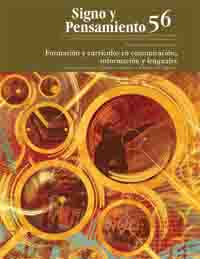Abstract
Based on cognitive science’s postulates, we propose an innovative way to teach journalism. The method stands on three main points: freedom vis-à-vis narrative approaches, playfulness vis-à-vis the appropriation of knowledge, and room for rectification in the process of evaluation. This paper collects the developments of an experience where this teaching method was applied during a class-course of journalism, having previously analyzed the competence and skills with which the students first arrived, and finally proposing a flexible methodology that articulates the contents, the workshops, and work produced with each group’s profile. The strategy here set out, was selected as the best educational innovation experience at Universidad del Norte in 2007, and is updated every semester through course feedback.
— (2008, 26 de octubre), “La impaciente generación ‘Y’”, El Tiempo, pp. 2-12.
Fiorillo, H. (2008), Escribir es lo que cuenta, Bar- ranquilla, Fundación La Cueva.
García, J. J. (1991), La nueva historia periodística, Medellín, Colección Mensajes-UPB.
— (1997), La dimensión hermenéutica del periodismo, Medellín, Colección Mensajes-upb.
Gardner, H. (1999), The Disciplined Mind, Nueva York, Simon & Schuster.
— (2001), Mentes creativas, Barcelona, Paidós.
— (2005a), Arte, mente y cerebro: una aproximación cognitiva a la creatividad, Barcelona, Paidós. — (2005b), El buen trabajo, Barcelona, Paidós.
— (2009), La educación de la mente y el conocimiento de las disciplinas, Barcelona, Paidós (Transiciones).
Gargurevich, J. (1997), Hacia nuevas maneras de enseñar y aprender periodismo, Barcelona, Paidós.
Grijelmo, A. (1997), El estilo del periodista, Madrid, Taurus.
Martínez, A. (diciembre de 2008) “Juegos de periodismo: una investigación aplicada en el aula” En: Investigación y Desarrollo, vol. 16, núm 2, pp. 305-325.
Martínez, A. y Durán, O. (2005), “Juan Gossaín según Howard Gardner, aunque ambos lo ignoren”, Revista Investigación y Desarrollo, vol. 13, núm. 2, Ediciones Uninorte.
— (2007), Juan el hijo de Juan:Travesía por las com- petencias extraordinarias de Juan Gossaín desde la perspectiva cognitiva del psicólogo Howard Gardner [tesis de maestría], Barranquilla, Biblioteca de la Universidad del Norte.
Nunes de Almeida, P. (2002), Educación lúdica, Bogotá, San Pablo.
Rodari, G. (1999), Gramática de la fantasía: introducción al arte de contar historias, Bogotá, Panamericana.
Schaefer, C. y O’Connor K. (1983), Manual de terapia de juego, México, Manual Moderno.
Stocking, S. H. y Gross, H. P. (1989). ¿How do Journalist Think? A Proposal for the Study of Cognitive Bias in Newsmaking, Bloomington, Smith Research Center Indiana University.
This journal is registered under a Creative Commons Attribution 4.0 International Public License. Thus, this work may be reproduced, distributed, and publicly shared in digital format, as long as the names of the authors and Pontificia Universidad Javeriana are acknowledged. Others are allowed to quote, adapt, transform, auto-archive, republish, and create based on this material, for any purpose (even commercial ones), provided the authorship is duly acknowledged, a link to the original work is provided, and it is specified if changes have been made. Pontificia Universidad Javeriana does not hold the rights of published works and the authors are solely responsible for the contents of their works; they keep the moral, intellectual, privacy, and publicity rights.
Approving the intervention of the work (review, copy-editing, translation, layout) and the following outreach, are granted through an use license and not through an assignment of rights. This means the journal and Pontificia Universidad Javeriana cannot be held responsible for any ethical malpractice by the authors. As a consequence of the protection granted by the use license, the journal is not required to publish recantations or modify information already published, unless the errata stems from the editorial management process. Publishing contents in this journal does not generate royalties for contributors.


